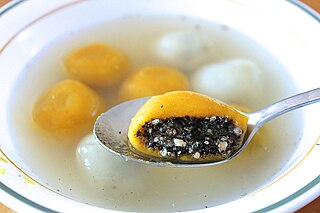
Korean cuisine has evolved through centuries of social and political change. Originating from ancient agricultural and nomadic traditions in Korea and southern Manchuria, Korean cuisine reflects a complex interaction of the natural environment and different cultural trends.

Glutinous rice is a type of rice grown mainly in Southeast and East Asia, Northeastern India and Bhutan which has opaque grains, very low amylose content, and is especially sticky when cooked. It is widely consumed across Asia.

Furikake is a dry Japanese condiment to be sprinkled on top of cooked rice, vegetables, and fish, or used as an ingredient in onigiri. It typically consists of a mixture of dried fish, sesame seeds, chopped seaweed, sugar, salt, and monosodium glutamate. Other flavorful ingredients such as katsuobushi, or okaka, freeze-dried salmon particles, shiso, egg, powdered miso and vegetables are often added to the mix.

Korean royal court cuisine was the style of cookery within Korean cuisine traditionally consumed at the court of the Joseon Dynasty, which ruled Korea from 1392 to 1910. There has been a revival of this cookery style in the 21st century. It is said that twelve dishes should be served along with rice and soup, with most dishes served in bangjja (bronzeware).

Shaobing, also called huoshao, is a type of baked, unleavened, layered flatbread in Northern Chinese cuisine. Shaobing can be made with or without stuffing, and with or without sesame on top. Shaobing contains a variety of stuffings that can be grouped into two main flavors: savory or sweet. Some common stuffings include red bean paste, black sesame paste, stir-fried mung beans with egg and tofu, braised beef, smoked meat, or beef or pork with spices.

A rice cake may be any kind of food item made from rice that has been shaped, condensed, or otherwise combined into a single object. A wide variety of rice cakes exist in many different cultures in which rice is eaten and are particularly prevalent in Asia. Common variations include cakes made with rice flour, those made from ground rice, and those made from whole grains of rice compressed together or combined with some other binding substance.

Tangyuan is a Chinese dessert consisting of balls of glutinous rice flour and water that are boiled or deep-fried and served in a hot broth or syrup. Tangyuan can be either small or large and filled or unfilled. They are traditionally eaten during the Lantern Festival, but because the name of the dish is a homophone for union they are also served on wedding days, at family reunions, and during the Dōngzhì festival.

Rice flour is a form of flour made from finely milled rice. It is distinct from rice starch, which is usually produced by steeping rice in lye. Rice flour is a common substitute for wheat flour. It is also used as a thickening agent in recipes that are refrigerated or frozen since it inhibits liquid separation.

Black sesame soup is a popular east-Asian and Chinese dessert widely available throughout China, Vietnam, Taiwan, Hong Kong, Malaysia and Singapore. It is typically served hot. In Cantonese cuisine it takes the form of tong sui, or sweet soup, with greater viscosity. The main ingredients are black sesame seeds, rice and water. Sugar is added for sweetness. Tangyuan is sometimes added into black sesame soup. Black sesame soup can be purchased in powder form.

Jiandui is a type of fried Chinese pastry made from glutinous rice flour. The pastry is coated with sesame seeds on the outside and is crisp and chewy. Inside the pastry is a large hollow, caused by the expansion of the dough. The hollow of the pastry is filled with a filling usually consisting of lotus paste, or alternatively sweet black bean paste, or red bean paste. They are also sometimes referred to as sesame balls.

Hangwa is a general term for traditional Korean confections. With tteok, hangwa forms the sweet food category in Korean cuisine. Common ingredients of hangwa include grain flour, fruits and roots, sweet ingredients such as honey and yeot, and spices such as cinnamon and ginger.

Chinese desserts are sweet foods and dishes that are served with tea, along with meals or at the end of meals in Chinese cuisine. The desserts encompass a wide variety of ingredients commonly used in East Asian cuisines such as powdered or whole glutinous rice, sweet bean pastes, and agar. Due to the many Chinese cultures and the long history of China, there are a great variety of desserts of many forms.

Sesame seed candy is a confection of sesame seeds and sugar or honey pressed into a bar or ball. It is popular from the Middle East through South Asia to East Asia. The texture may vary from chewy to crisp. It may also be called sesame (seed)candy/bar/crunch; sesame seed cake may refer to the confection or to a leavened cake or cookie incorporating sesame.

Heugimja-juk or black sesame porridge is a Korean porridge, or juk, made from finely ground black sesame and rice. The bittersweet, nutty porridge is good for recovering patients, as black sesame seeds are rich in digestive enzymes that help with healthy liver and kidney functions.

































